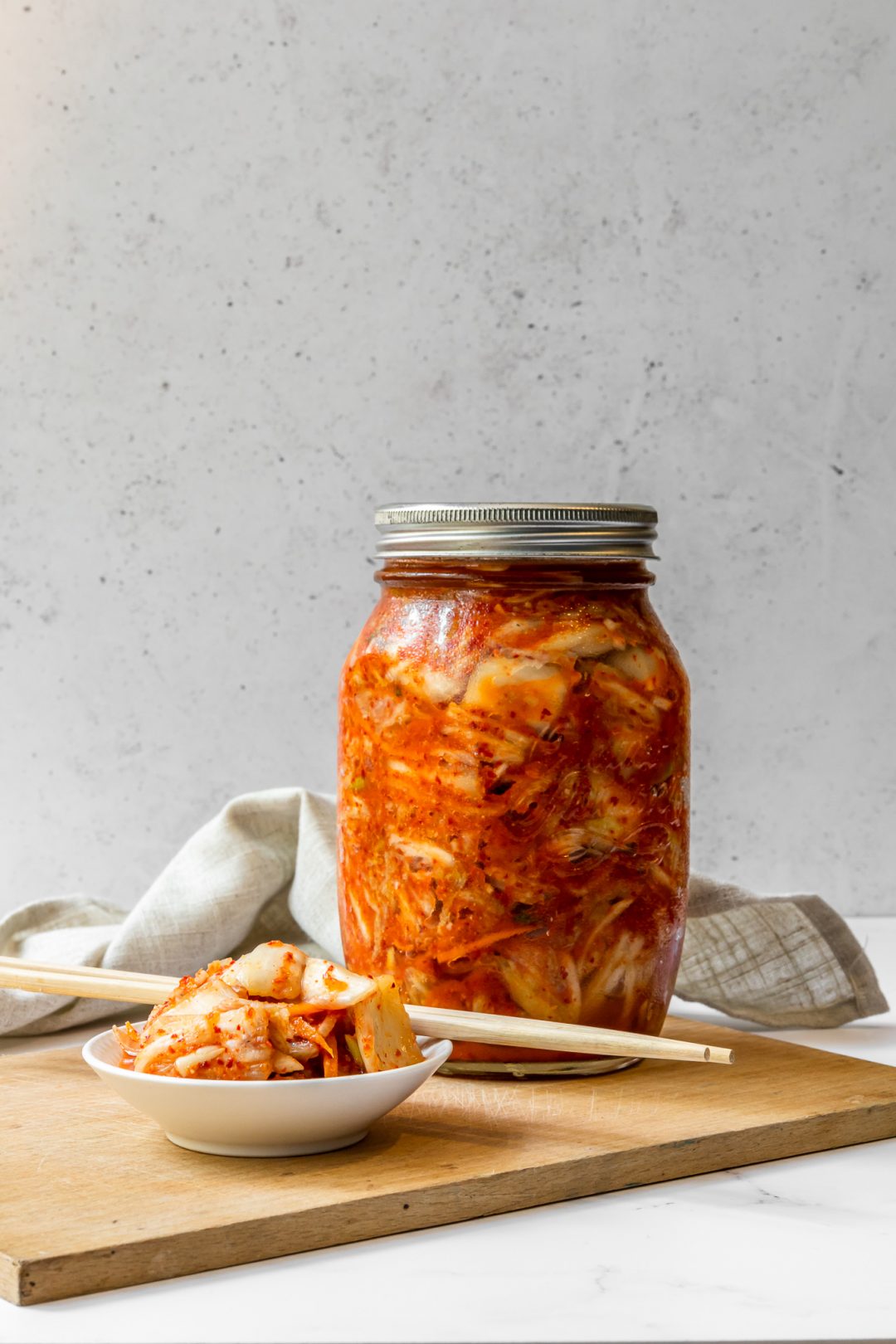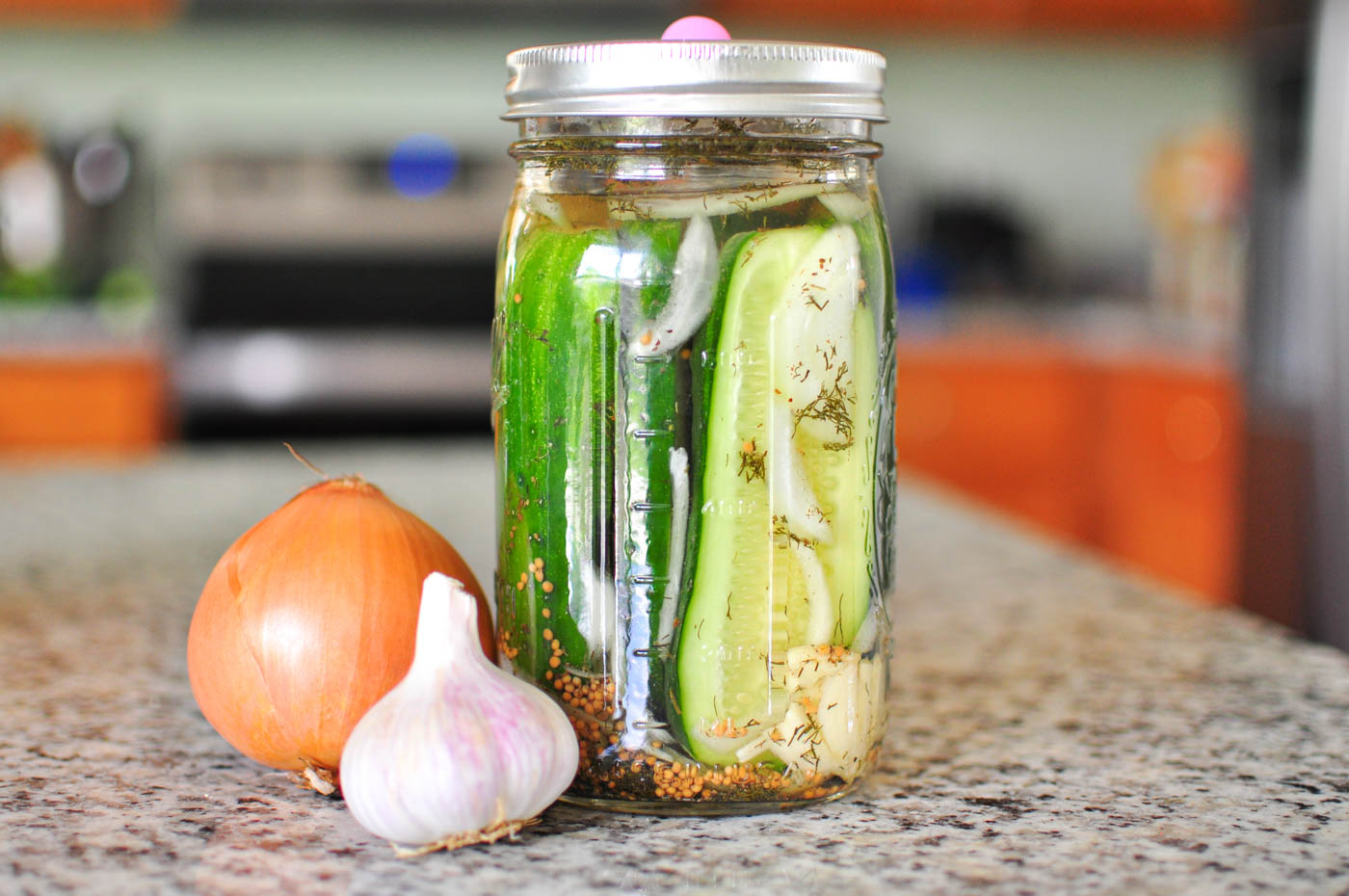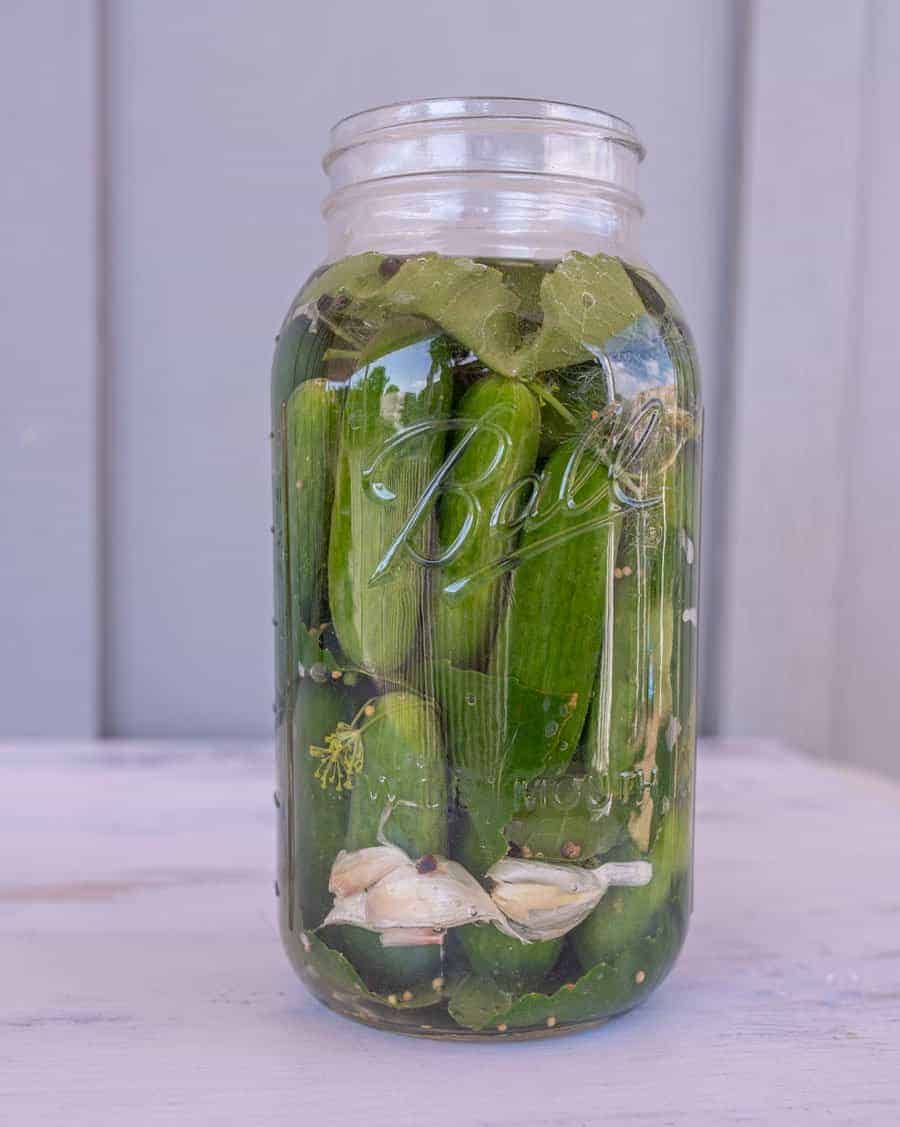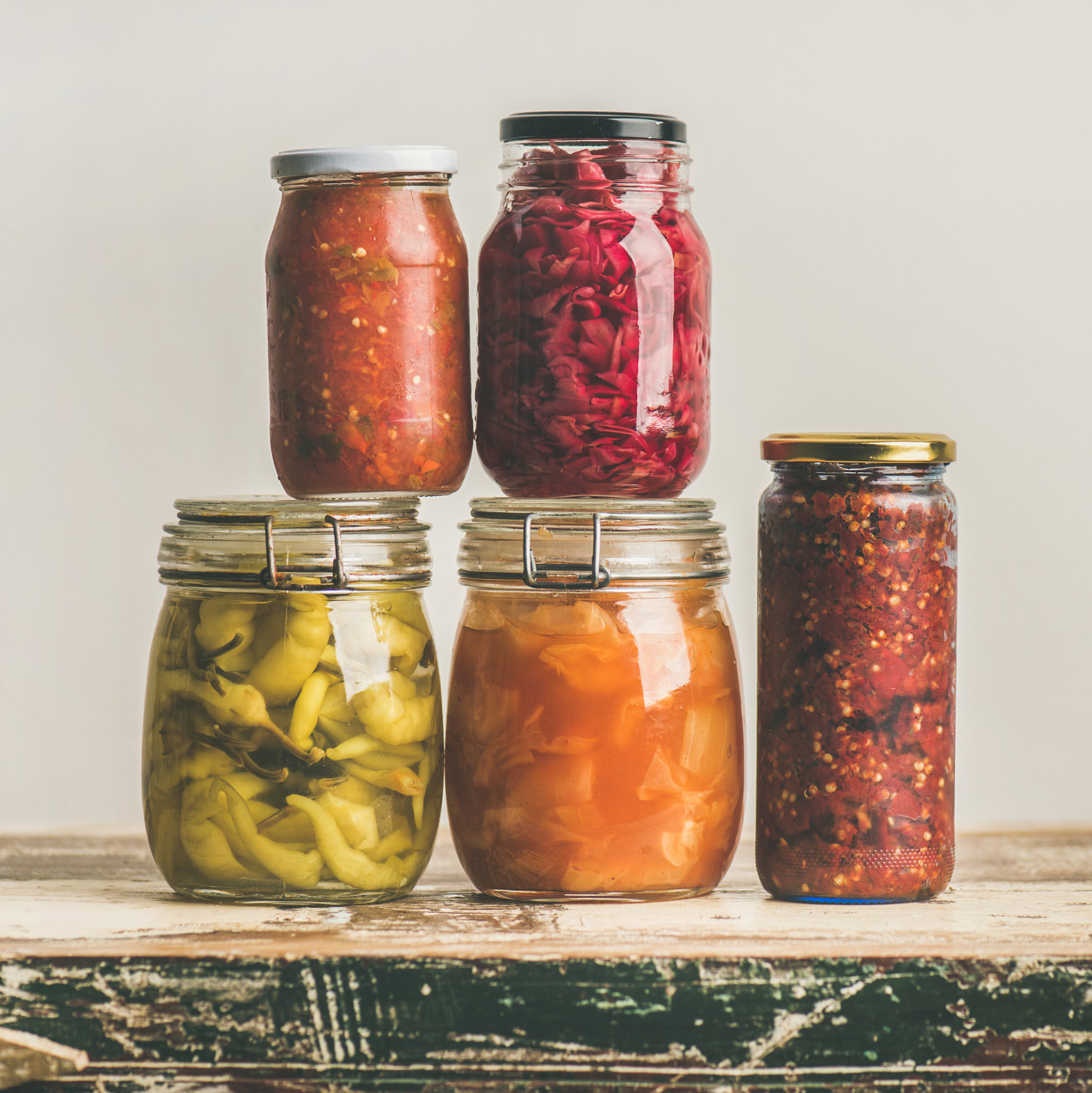You can make all kinds of different pickle spice combinations when you make small batches of fermented pickles.
You can add garlic, dill weed, dill seed, peppercorns, mustard seed, whole cloves, whole allspice, and even onion slices. You can also use this pickling spice recipe to make a batch and have it ready so you don’t have to
open
a bunch of jars every time you want to make fermented pickles. Just keep notes of what you put in each jar so you can recreate the ones you liked best.
Let’s take a moment to think about this and compare the difference between these two preserving methods. Vinegar pickles-pickles made with vinegar usually require a blend of water, salt and a white or apple cider vinegar. While you can make refrigerator vinegar pickles, most homemakers either preserve their own in the canner or buy them already canned. This means your pickles have been exposed to heat, which kills natural enzymes and some of the vitamins found in your cucumbers. In most cases, vinegar pickles are a “cooked” vegetable. Fermented pickles-pickles that are traditionally fermented in a salt water brine are left in their raw form, meaning less is lost nutritionally.
Put simply, pickling preserves foods by immersion in a vinegar brine or a saltwater brine to suppress microbes that cause food to rot. Depending on the method you use, the process can take a few hours or days for vinegar-brined pickles to be ready to eat, or weeks for saltwater-brined pickles (also called fermented or sour pickles) to reach pickle perfection.
My love of pickles jumped several levels the moment i tasted my first batch of fermented pickles. I grew up with some delicious pickles: homegrown veg stuffed into jars, covered in vinegar brine, and sealed to enjoy all year. And i share many of those classic family recipes, some with modern twists for safety or flavor, in my new cookbook, the complete guide to pickling. But i must admit: if you want to make truly amazing pickles, ferment them. I talk a lot about fermentation in my new book. Whether you’re new to fermenting or have already fallen for salt brine, be sure to check out chapter 1, where i explain the differences between vinegar-preserved and fermented pickles and walk you through my fermentation process, step by step; i also describe some of my favorite fermenting ingredients and tools in that chapter and offer many shortcuts for simply using what you already have in your kitchen.
Can fermented pickles be canned?
Aside from the wonderful taste, fermented pickles are a great source of probiotics.
 Fermenting veggies is an easy way to ensure that you can easily incorporate more probiotics into your diet. Most of us are used to canned foods, especially since all the pickles available in grocery stores are canned. But fermentation is an old preservation method and it was used back in the day to preserve food for winter. It’s also a method that requires less work than canning. Both methods can give you delicious pickles so let’s analyze the two methods and see how fermentation differs from canning.
Fermenting veggies is an easy way to ensure that you can easily incorporate more probiotics into your diet. Most of us are used to canned foods, especially since all the pickles available in grocery stores are canned. But fermentation is an old preservation method and it was used back in the day to preserve food for winter. It’s also a method that requires less work than canning. Both methods can give you delicious pickles so let’s analyze the two methods and see how fermentation differs from canning.
To ensure safety, and to mimic the sour taste of a fermented pickle, vinegar, salt, and spices were added to the jars of canned pickles. Once processed in a water bath canner for 10 minutes, the pickles could be safely stored for a full year at least. Although vinegar itself can contain active cultures that would make it considered probiotic, the process of distillation (for distilled white vinegar) and later, the heat of the water bath canner, kill off any bacteria. The heat processing can cause a softening of the characteristic pickle crunch, so over the years various additives have been included in recipes to prevent the dreaded mushy pickle syndrome.
Fermented Pickles Recipe: Easy Crunchy Brined Cucumber Dill Pickles
Learn how to make real probiotic-rich lacto-fermented pickles with this easy step-by-step recipe, a perfect project for a small or large batch of cucumbers! (this post is a contribution by melissa keyser ) my dad hates cucumbers. So much hate we couldn’t even have them in the house, he even detested the smell. So as a result, i didn’t eat many of them growing up. But when i started living on my own and cooking seasonally, i’d pick cucumbers up at the farmers market, enjoying them sliced with a bit of salt or grating into yogurt as a dip. My dad, however, was fine with pickles.
And that’s how to make fermented dill pickles.
When fermenting dill pickles at home, cleanliness is critical. Hands, countertops, bowls, utensils, etc. , must be very clean as bacteria, yeast, and mold which cause spoilage may be accidentally introduced. This can lead to a batch of pickles smelling foul, turning mushy or slippery, and changing to an off-color.
Links may be partner or affiliate links, including amazon associates. Questions or comments? i’d love to hear from you! email me at camille@growingupgabel. Com. 352 shares making sour fermented pickles is easier than it seems. Pickles ferment in a simple brine for about a week until they are half or full sour to your preference. Fermenting pickles is a great way to preserve the summer harvest! if you’ve ever eaten a pickle in a jewish deli, you know the wonder of a full-sour or half-sour pickle. These are fermented pickles, and they are easy to make at home. Simply put pickling cucumbers in a large jar with dill, garlic, and coriander.
Fermented or brined products, such as dill cucumbers, cure for several weeks. Curing changes the color, flavor and texture of the product. Lactic acid produced during fermentation helps preserve the product. Satisfactory products can be obtained only when quality ingredients are used and proper procedures followed. Correct proportions of vegetables, salt, vinegar and spices are essential.
Fermenting and pickling are methods of preserving food that has been used generation after generation. The difference lies in how they’re preserved. Many people get confused over what pickling & fermenting is. Both a pickled cucumber and a fermented cucumber will often be called pickles. Just to confuse everyone even more, the term “pickling” can sometimes mean pickling with vinegar or fermenting. In this guide, pickles mean submerging something in vinegar and fermenting is submerging something in water & salt. Pickling and fermenting at home are cost-effective and healthier alternatives to shop-bought products, allowing you to experiment with all different flavours.
Fermented pickles salt water brine
Having a big jar of super garlicky, dill-packed pickle slices in the fridge is an absolute must for us. These are the pickles that we are scooping out to stuff into sandwiches, burgers or to tide us over as we contemplate what’s on hand to make for dinner. Cucumbers, for how ubiquitous they are with fermentation, can be one of the trickier vegetables to master. Their super high water content can lead to pickles that are mushy or hollowed out if the brine or cucumbers aren’t matched just right. For the snappiest pickles, we employ a few tried and true tips: using very fresh pickling cucumbers, shocking them in an ice-bath before fermenting, adding tannins, and keeping the salt content high and fermentation period short.
Clean the cucumbers well and let them soak in cold water with the ice cubes for 4 to 8 hours. This step will help them stay crunchy until after fermentation. Prepare the brine by dissolving the salt and sugar in the water. Stack the pickles, whole or sliced (depending on your family traditions), in the jars. Divide the grape leaves (if using), the garlic cloves, dill sprigs, pepper, caraway and cumin between the two jars. Cover with sweet brine (with 4% salt). Close the jars and place an airlock. Otherwise, completely close the lid, but release the pressure once a day for the first 3 days: slightly unscrew the adjustment ring for a few seconds, then close tightly.
Back to top lacto-fermentation is the process that produces traditional dill pickles, kimchi , and real sauerkraut , among other fermented delights. This simple fermentation process requires nothing more than salt, vegetables, and water—no canning, no fancy equipment.
It depends on the kind of pickle! today's pickles are usually pickled, but they are pickled in a brine that has been fermented. Usually this brine is vinegar. However, when pickles first appeared on the scene, they were fermented. Dunked in a salty brine and left to ferment for a few days, these pickles are still produced in small batches by artisanal foodies and home cooks across the world. You are extremely unlikely to find fermented pickles in the grocery store, but if you do they are worth the purchase! some people think that fermented pickles are even better than pickled pickles.

 It often also includes julienned daikon radishes and carrots; sometimes asian pears or apples are added to the brine for sweetness. Other ingredients can be added or subbed in, such as oysters (although the oysters can break down within the kimchi if kept too long, so it’s best to eat within 2 to 3 weeks), or minari, which would give the kimchi herbaceous flair but could overpower the other ingredients.
It often also includes julienned daikon radishes and carrots; sometimes asian pears or apples are added to the brine for sweetness. Other ingredients can be added or subbed in, such as oysters (although the oysters can break down within the kimchi if kept too long, so it’s best to eat within 2 to 3 weeks), or minari, which would give the kimchi herbaceous flair but could overpower the other ingredients. นิธิยา รัตนาปนนท์
กิมจิ (kimchi) เป็นอาหารพื้นเมืองของประเทศเกาหลี ใช้รับประทานเป็นเครื่องเคียง ( side dish ) เสริฟพร้อมกับอาหารประเภทเนื้อสัตว์ วัตถุดิบหลัก คือผักกาด หัวไชเท้า ต้นหอม พริกชี้ฟ้า กระเทียม ขิง น้ำปลา เกลือ น้ำตาล ที่ผ่านการหมัก ( fermentation ) ให้เกิดกรดแล็กทิก ( lactic acid fermentation ) ด้วยจุลินทรีย์ที่ผลิตกรดแล็กทิก ( lactic acid bacteria ) มีรสเปรี้ยว และเค็ม เผ็ดเล็กน้อย.
นิธิยา รัตนาปนนท์
กิมจิ (kimchi) เป็นอาหารพื้นเมืองของประเทศเกาหลี ใช้รับประทานเป็นเครื่องเคียง ( side dish ) เสริฟพร้อมกับอาหารประเภทเนื้อสัตว์ วัตถุดิบหลัก คือผักกาด หัวไชเท้า ต้นหอม พริกชี้ฟ้า กระเทียม ขิง น้ำปลา เกลือ น้ำตาล ที่ผ่านการหมัก ( fermentation ) ให้เกิดกรดแล็กทิก ( lactic acid fermentation ) ด้วยจุลินทรีย์ที่ผลิตกรดแล็กทิก ( lactic acid bacteria ) มีรสเปรี้ยว และเค็ม เผ็ดเล็กน้อย. Today, gmfh’s editorial staff offers you a selection of material developed by the international scientific association for probiotics and prebiotics (isapp) to better understand these bacteria.
Today, gmfh’s editorial staff offers you a selection of material developed by the international scientific association for probiotics and prebiotics (isapp) to better understand these bacteria. But supplemental probiotics, consumed naturally or in supplement form, can help restore a healthy gut microbiome. A 2018 study published by the national institutes of health (nih) indicates probiotics support immune function, digestion, and nutrition absorption. Another 2018 nih study notes that probiotics can decrease the risk or duration of common infections, including those of the respiratory tract and gut. With this in mind, we went to work and tried a handful of top-rated probiotics, spanning a range of budgets and particular gut health needs.
But supplemental probiotics, consumed naturally or in supplement form, can help restore a healthy gut microbiome. A 2018 study published by the national institutes of health (nih) indicates probiotics support immune function, digestion, and nutrition absorption. Another 2018 nih study notes that probiotics can decrease the risk or duration of common infections, including those of the respiratory tract and gut. With this in mind, we went to work and tried a handful of top-rated probiotics, spanning a range of budgets and particular gut health needs. But it certainly makes a fine side dish all on its own to go with any asian meal. Here are some of our favorite korean recipes that i serve with fresh kimchi:
bulgogi (korean grilled beef)
gluten-free korean veggie pancake
japchae (korean stir-fried noodles).
But it certainly makes a fine side dish all on its own to go with any asian meal. Here are some of our favorite korean recipes that i serve with fresh kimchi:
bulgogi (korean grilled beef)
gluten-free korean veggie pancake
japchae (korean stir-fried noodles)..JPG)
 Add the other garlic and remaining spices. Dissolve salt in the hot water and then add vinegar. Pour into jar. It should cover the pickles by at least an inch. Seal loosely with a ring and cap, or tie some cheesecloth over the top.
Add the other garlic and remaining spices. Dissolve salt in the hot water and then add vinegar. Pour into jar. It should cover the pickles by at least an inch. Seal loosely with a ring and cap, or tie some cheesecloth over the top. ”probiotics are said to restore the balance of bacteria in the gut when it has become disrupted through long-
”probiotics are said to restore the balance of bacteria in the gut when it has become disrupted through long-
 My impression of preserving
My impression of preserving

 The ability of probiotics to establish in the gi tract is enhanced by their ability to eliminate competitors. Some antimicrobials with producer organisms are enlisted in table 3. In different studies on humans and animals, beneficial microorganisms are used to improve the colonization resistance on
The ability of probiotics to establish in the gi tract is enhanced by their ability to eliminate competitors. Some antimicrobials with producer organisms are enlisted in table 3. In different studies on humans and animals, beneficial microorganisms are used to improve the colonization resistance on
 However, this conclusion was considered tentative because the quality of the studies was only moderate. Patients who were given probiotics had no more side effects than patients who didn’t receive them.
However, this conclusion was considered tentative because the quality of the studies was only moderate. Patients who were given probiotics had no more side effects than patients who didn’t receive them.:max_bytes(150000):strip_icc()/__opt__aboutcom__coeus__resources__content_migration__serious_eats__seriouseats.com__recipes__images__2017__08__20170808-preservation-acid-pickling-vicky-wasik-15-b3c5c7b0b1494aa285a99689aa70bae5.jpg)
 Temperatures of 55º to
65ºf are acceptable,
but the fermentation will take 5 to 6 weeks. Avoid temperatures above 80ºf, or pickles will
become too soft during fermentation.
Temperatures of 55º to
65ºf are acceptable,
but the fermentation will take 5 to 6 weeks. Avoid temperatures above 80ºf, or pickles will
become too soft during fermentation.